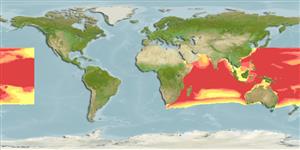Common names from other countries
>
Myctophiformes (Lanternfishes) >
Myctophidae (Lanternfishes) > Myctophinae
Etymology: Benthosema: Greek, benthos = depth of the sea + Greek, sema, sematos = signal, flag (Ref. 45335).
More on authors: Gilbert & Cramer.
Environment: milieu / climate zone / depth range / distribution range
Ekologi
marina batypelagisk; havsvandrande (Ref. 51243); djupintervall 0 - 2000 m (Ref. 26165). Deep-water; 33°N - 42°S, 19°E - 139°W
Indian Ocean: 18°N-20°S, to 42°S in the Agulhas Current. Pacific Ocean: 21°N-10°S.
Length at first maturity / Size / Vikt / Age
Maturity: Lm ?, range 4 - ? cm
Max length : 10.0 cm TL hane/ej könsbestämd; (Ref. 9835)
Taggstrålar i ryggfenan (totalt) : 0; Mjukstrålar i ryggfenan (totalt) : 12 - 14; Taggstrålar i analfenan: 0; Mjukstrålar i analfenan: 18 - 20; Ryggkotor: 31 - 32. Anal organs 10-11; mature males have large 3 to 5 translucent supracaudal gland and smaller infracaudal gland; mature females have small supracaudal gland and much smaller infracaudal patches (Ref. 39633).
Benthopelagic and mesopelagic in slope and oceanic waters, but usually not high-oceanic. Occurs in the upper 200 m at night (Ref. 4066). Epipelagic in nearshore areas at 0-856 m (Ref. 58302). Occasionally seen during dark nights on slopes that are near very deep water. Attracted by light like moths, becoming disoriented and darting frantically in all directions (Ref. 48635).
Life cycle and mating behavior
Maturities | Reproduktion | Spawnings | Egg(s) | Fecundities | Larver
Paxton, J.R. and P.A. Hulley, 1999. Myctophidae. Lanternfishes. p. 1957-1964. In K.E. Carpenter and V.H. Niem (eds.) FAO species identification guide for fishery purposes. The living marine resources of the WCP. Vol. 3. Batoid fishes, chimaeras and bony fishes part 1 (Elopidae to Linophrynidae). FAO, Rome. (Ref. 9835)
IUCN Red List Status (Ref. 130435)
CITES (Ref. 128078)
Not Evaluated
Threat to humans
Harmless
Human uses
Fiskeri: av potentiellt intresse
Verktyg
Special reports
Download XML
Internet-källor
Estimates based on models
Preferred temperature (Ref.
115969): 5.6 - 14.4, mean 8.9 (based on 788 cells).
Phylogenetic diversity index (Ref.
82804): PD
50 = 0.5312 [Uniqueness, from 0.5 = low to 2.0 = high].
Bayesian length-weight: a=0.00871 (0.00387 - 0.01962), b=3.11 (2.92 - 3.30), in cm Total Length, based on LWR estimates for this (Sub)family-body shape (Ref.
93245).
Trofisk nivå (Ref.
69278): 3.2 ±0.33 se; based on food items.
Resiliens (Ref.
120179): Hög, lägsta populationsfördubblingstid mindre än 15 månader (K=5.62; tmax=1).
Fishing Vulnerability (Ref.
59153): Low vulnerability (10 of 100).
